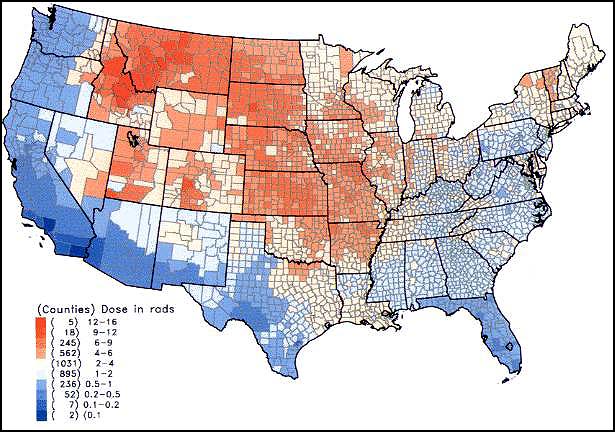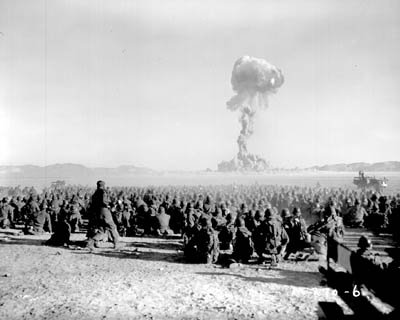|
Nuclear Bombs and Thyroid Cancer: The Milk Connection 
Map courtesy of the National Cancer Institute
From 1951 to 1958 the U.S. government conducted 90 above-ground nuclear bomb tests in the desert northwest of Las Vegas, Nevada, sending particles contaminated with radioactive iodine-131 (fallout) across much of the country. According to a 1997 report from the National Cancer Institute, the county with the highest per capita dose of radioactive Iodine 131 from the bomb tests was Montana's Meagher County located between Bozeman and Great Falls (White Sulphur Springs area). Furthermore 15 of the 25 counties with the highest doses of Iodine-131 are in Montana. Those "hot spots" are the brightly-shaded counties on the map shown above. The distribution of fallout from each of the bomb tests was dependent on the strength and direction of winds, especially the jet stream, at the time of the explosion.
 Casualties of the Cold War . . . Casualties of the Cold War . . .
Iodine-131 is a radioactive isotope that decays rapidly in the environment. In fact its radioactivity is reduced by half every eight days (half-life), so it is only dangerous for about two months. But if it is ingested before it breaks down, it concentrates in the thyroid gland, which is made up of the only cells in the body able to absorb iodine. There the I-131 can cause thyroid cancer, which may not appear for several decades. The National Cancer Institute estimates that exposure to fallout from the bomb tests could produce over 200,000 excess cases of thyroid cancer.
Got milk? . . .
The primary way that people were exposed to I-131 was by drinking contaminated milk. The radioactive iodine was carried over Montana as part of the fallout, and fell on pastures where it was eaten by cows, contaminating their milk. Smaller amounts contaminated other dairy products and leafy vegetables. Children of that era (people ranging in age from late 40s to mid 60s now) are at higher risk for a couple reasons. 1. Children generally drink more milk than adults.2. Children have smaller thyroids. Therefore, with children, more radioactive Iodine-131 would have built up in a smaller amount of tissue. Furthermore if children in areas such as Meagher County consumed fresh milk directly from the cow, their exposure to radiation would have been even greater. Fresh milk from backyard or farm cows usually contained more I-131 than store-bought milk because processing and shipping milk allowed more time for the radioactive iodine to break down.
Montanans excluded . . .
In a report by the National Cancer Institute, released in 1997, it was determined that ninety atmospheric tests at the Nevada Test Site deposited high levels of radioactive iodine-131 across a large portion of the United States, especially in the years 1952, 1953, 1955, and 1957 . . . doses large enough to cause anywhere from 10,000 to 75,000 cases of thyroid cancer. The Radiation Exposure Compensation Act of 1990 allowed for people living downwind of test site for at least two years in particular Nevada, Arizona or Utah counties, between 21 January 1951 and 31 October 1958, or 30 June and 31 July 1962, AND suffering from certain cancers or other serious illnesses deemed to have been caused by fallout exposure to receive compensation of $50,000. By January 2006, over 10,500 claims had been approved, and around 3,000 denied, for a total amount of over $525 million in compensation dispensed to "downwinders". Unfortunately, victims who were living in Montana counties at the time of the tests were not included in the program.
A little good news . . .
Thyroid cancer is a very slow growing cancer and accounts for only 1 percent of all cancers in the United States. An estimated 16,100 cases will be diagnosed this year with 1,230 being fatal. It is a highly curable cancer with the five-year survival rate at 95 percent.
Terms: isotope, half-life
|


